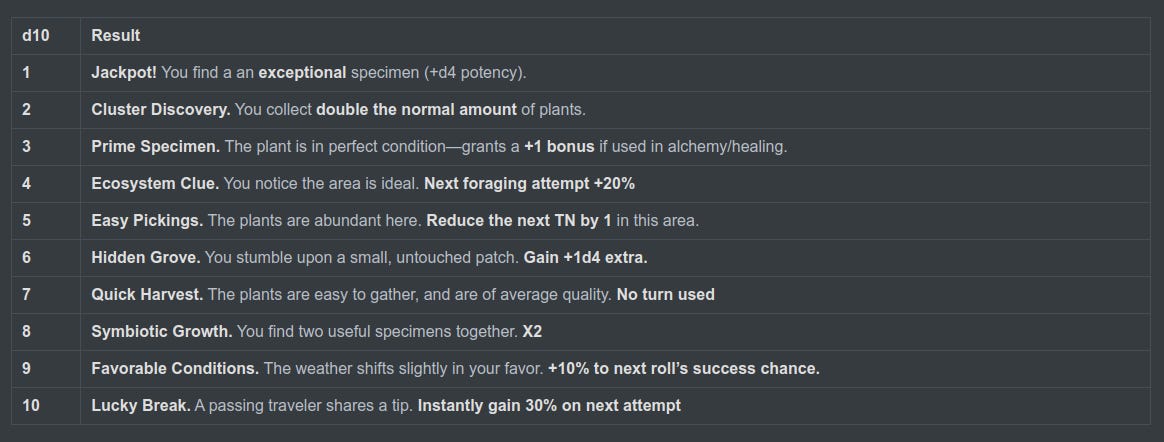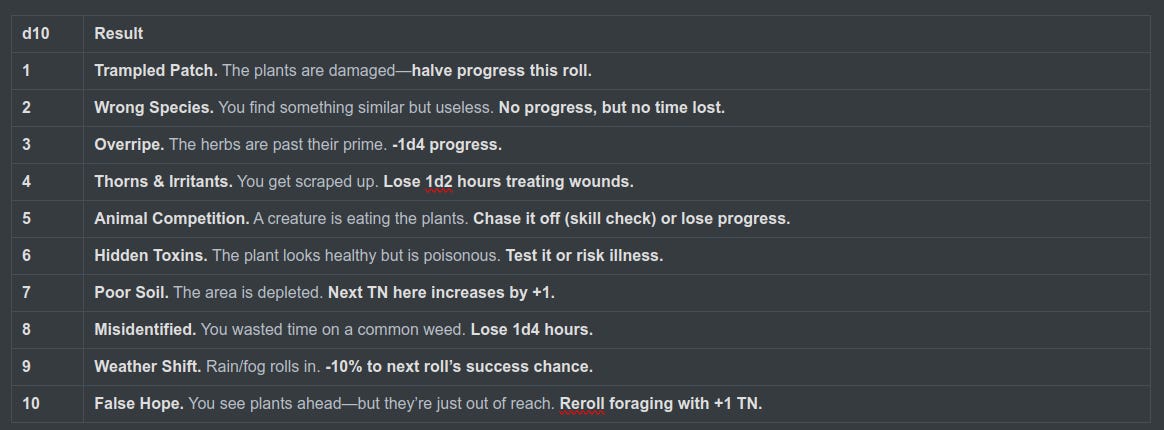Dynamic Foraging: A Probability-Driven Approach to Herb Hunting
A Bell-Curve System for Finding Herbs in the strangest of places...
Spent the better part of the morning poking holes through a jungle of wild oats. They're just over two feet tall now—tall enough to throw shade on the smaller plants trying to live their quiet lives beneath them. Little pockets of oregano, peppermint, lamb’s ear, new goji berry plants, soapwort, and a handful of others that have claimed space wherever fate dropped them. I’ve got most of their hiding spots memorized. Others I stumble across by accident. And yes, I’m sure I’ve missed a few. “I’ll find you later in the season when the oats go to seed,” I whispered, to no one in particular—and maybe to a few leafy souls I accidentally buried in shadows.
All the while, I was nibbling here and there—this leaf, that flower—because let’s be honest, gardening is basically outdoor snacking. Which brings me, neatly enough, to this week’s topic—a brief introduction to the Alchemy Mechanic I keep teasing, starting with tracking down and finding the plants using a basic foraging mechanic. Keep in mind this might also change down the line, but for now this is what I've come up with so far...
You’re going to need some basic foraging skills if you plan on brewing your own potions and sleep bombs, aren’t you? Or are you planning to stick with that sketchy dealer of yours forever? Hm? What’s the plan?
Remember that last delirium powder bomb you picked up from them? Yeah, the one that was supposed to confuse the guard? Instead, he flew into a berserker rage and murdered six people, screaming something about demon eyes. We don't want a repeat of that...
So, I've attempted to create a structured foraging mechanic, incorporating dynamic probability, dice-based risk/reward, sprinkled with complications.
Sound familiar? It just might. I created foraging mechanic back when first started The Roll Playing Buddha, almost two years ago now. I'm using similar mechanics, here, but it's less visually available; meaning that tracking is done a bit differently. But we'll get to that later. First let's take a look at the core foraging mechanic and then we'll expand the field of view as we go.
Core Mechanic: Dynamic Foraging System
Determine Base Success Chance
First we establish a Base Chance: 50% (adjustable to suit you needs/situation). We need to start someplace and dead middle is probably suitable for most situations. Next we apply modifiers to our Base Chance based on various factors such as season, time of day, and weather. I've kept them simple here, but you can complicate them more based on your personal needs and or play style.
Base Chance: 50% (adjustable based on campaign difficulty). Modifiers (apply to base chance):
Factor in any given condition and total everything together, even if it goes over 100% or under 0%. Anything over 100% is subtracted from your chances and are considered complications that deem the situation too perfect, therefore prone to things going wrong. Anything below 0% should be rounded backwards so that it's added to your total chances; representing conditions where things are so bad, the gods decide to shift the scales in your favor. For example, if the grass is two feet tall, you very well cannot see what' growing in the shadows underneath.
Checks for Complications ca occur either before or after a foraging a check. Follow your inner bell.
Assign Dice Pool
Map the adjusted success chance to a bell-curve influenced dice pool:
*Success rates approximate based on TN and dice combinations.
Bell Curves 101
If you you've never heard of a bell curve, let me break it briefly break it down for you. When you roll multiple dice and add their results, the probabilities of outcomes form a bell curve (a normal distribution). This means that Mid-range values are more likely than extreme highs/lows due to there being more combinations that add up to these middle values and less combinations that add up to the lower results. More dice = a steeper curve, making results cluster around the average.
Example: 2d6 vs 1d12
2d6 (two six-sided dice):
Possible sums: 2–12.
7 is the most common result (6/36 or ~16.7% chance).
Probability tapers toward extremes (2 and 12 each have ~2.8% chance)
1d12 (one twelve-sided die):
All numbers 1–12 have equal probability (~8.3% each).
Smaller dice pools (2d4) create steep curves, favoring results near the average (5 on 2d4). This makes success more reliable in high-chance zones (like forests). Larger dice pools (2d10) flatten the curve slightly, spreading results wider, which reflects the risk/reward of foraging in harsh areas (like deserts).
Tension Between Risk and Consistency are also present when using this method. Players can strategize around dice pools. For example, 2d4 (TN 6) has a ~81% success rate, but results cluster around 5–7. We could consider TN as a direct success, and the outer as not just close, but a push in one direction or another. In the case of a 2d6, a 7 indicates an average success. We might consider the next lower value to be a lessor success, or perhaps a sign that we're heading in the wrong direction; the lowest value in this case would indicate a dead end.
The next highest value could trigger a higher success, an exceptionally healthy specimen, or perhaps a cluster of plants, giving us more than we need. Or it could indicate that we're close, but not quite in the right area yet.
Of course any other value simply means you've found nothing this turn, in this area, try another spot, or try again, maybe you missed something. A non-successful attempt is simply an action without fruition. Consider this a turn, a chance to move to another location, or simply that, nothing happens this time. And sometimes it's nice when nothing is happening. It gives us a moment to settle into the given moment. So look around us and notice the things we see, but don't really pay much attention too. There's no mechanic for looking around and observing the world around you (I can create one if if you'd like), but it's an often an unspoken requirement if you're trying to see if you're in the right area. In the right state of mind to even deal with the things around you. Sometimes your not, and that's okay too.
If you remember too, stop and take a look around you every so often. Remind yourself that you're alive and take a look at how it feels to be aware of this present moment. This can be quite helpful during solitaire play when you don't have a GM to fill in the subtle details of what the forest feels like; do you feel alone, or do you sense that there is an omnipresence that exists in this wild space? Let your senses and imagination fill in the visual details as well.
It's often enough to sit with your self for moment and imagine the space your in; your body and senses will fill in the details for you if you let them. Let that happen and allow things to unfold in front of you. Sometimes that's hard to do because we want to be in control of everything. Learning to embrace the lack of control is vital to not only your mental health, but also your solitaire roleplaying experience; it adds to the mystery of the experience and saves you time rolling on tables to see what's there.
Speaking of tables, let's roll out some to help us when we roll one of those outer values shall we?
Higher-Value Table (Above Target Number)
Rolled one value above the TN? Roll 1d10 for an extra effect:
Lower-Value Table (Below Target Number)
Rolled one value below the TN? Roll 1d10 for a complication or partial success:
Example Playthrough: "The Wilted Petal"
I’m a wandering herbalist named Elias, searching for Silverleaf to cure a fever plaguing a nearby village. The forest is my best hope.
Step 1: Determine Base Chance
Conditions:
Season: Spring (+20%)
Weather: Clear (+10%)
Location: Forest (+40%)
Time of Day: Day (+20%)
Temperature: Normal (+0%)
Adjusted Success Chance: 50% (Base) + 20% + 10% + 40% + 20% = 140%
"The forest is vibrant—sunlight dapples through fresh leaves, and the air hums with life. But it’s almost too perfect; the undergrowth is so thick I might miss the Silverleaf hidden beneath."
Complication: 140% is over 100%, so we subtract the excess: 140% - 100% = 40% (This becomes the complication chance—more on this later.)
Final Success Chance: 100% - 40% = 60%
Dice Pool: 60% falls in the 50–74% range → 2d6 (TN 7)
Step 2: First Foraging Attempt
I kneel by a mossy log, scanning for Silverleaf’s telltale silver-veined leaves.
Roll: 2d6 = 3 + 5 = 8 (One above TN 7) "Aha! A patch of Silverleaf glints in the sunlight. But something feels... off."
Higher-Value Table (Roll 1d10): d10 = 6 → Hidden Grove (+1d4 extra herbs) d4 = 3 → "I push aside ferns and find a secluded cluster—three extra plants!"
Progress: Found 4 Silverleaf (1 base + 3 bonus).
Step 3: Check if Complication Strikes
The 40% complication chance triggers. Roll 1d100: d100 = 22 (≤40%) → "A rustling in the bushes—I freeze. A wild boar eyes me, its snout buried in the same patch I’m foraging."
Lower-Value Table (Roll 1d10): d10 = 5 → Animal Competition "The boar grunts, unwilling to share. I need to scare it off."
Skill Check (Improvised):
TN 10 (2d6 + Survival skill modifier; I have +2). Roll: 2d6 + 2 = 4 + 3 + 2 = 9 (Failure) "I clap my hands, but the boar charges! I barely dodge—it tramples half the Silverleaf."
Result: Lose 2 Silverleaf (halved progress).
Inventory: 4 → 2 Silverleaf remaining.
Step 4: Second Foraging Attempt
I retreat to a quieter glade, ears still ringing from the boar encounter.
Success Chance: Still 60% (2d6, TN 7). Roll: 2d6 = 2 + 4 = 6 (One below TN 7)
Lower-Value Table (Roll 1d10): d10 = 8 → Misidentified (Lose 1d4 hours) d4 = 2 "I spend two hours harvesting what turns out to be common moonwart—useless for the fever."
Time Lost: 2 hours (now late afternoon).
Step 5: Final Attempt
The light is fading. I whisper a prayer to the Green Mother and try one last spot.
Success Chance: 60% (2d6, TN 7). Roll: 2d6 = 6 + 1 = 7 (Exactly TN 7) "There—beneath an oak, a single Silverleaf plant, untouched and perfect."
Result: Found 1 Silverleaf.
Total Harvest: 2 (from earlier) + 1 = 3 Silverleaf.
Conclusion
"Three Silverleaf won’t cure the whole village, but it’s enough to start. As I pack my satchel, the wind carries the scent of rain. Tomorrow’s foraging will be harder—but for now, I’ve done what I can."
..and that’s it for this week. A bit shorter than I’d like, but I stent a good portion of the day outdoors, and the remaining bit revising these mechanics a bit, trying to put them together into something that makes sense. I hope you find them useful, more to come concerning the Alchemy Mechanic. I have much to show you, including herbal bomb recipes; sachets filled with powdered herbs, that when thrown, break open when they hit a hard surface, (human head) and the powdered herbs fly about, effecting those in the vicinity.
There’s more to alchemy then just making potions, in case you didn’t know…
Stay curious, and take care of yourselves, and watch out for those around you. We’re all trying to find our way and all we’ve got is one another. See you next week.





